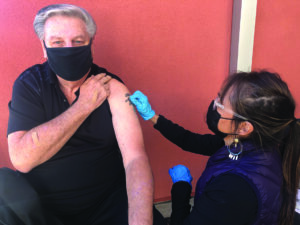The Northside has a checkered record so far when it comes to neighborhood residents vaccinated against COVID-19, with some areas surpassing city and national averages and others still trying to catch up as of late August.
The good news: By late August, Vaccination rates were inching higher across metro Denver, a trend local health officials want to continue as the seasonal flu period approaches late in the year.
The Metro Denver Partnership for Health, comprising COVID strategy groups to coordinate work by CDPHE, the Colorado Health Institute, Denver Public Health, Gov. Jared Polis’ office and others, is tracking vaccination status with an interactive map available at https://www.coloradohealthinstitute.org/metro-denver-covid-19-vaccination-map.

Although the data are grouped by U.S. Census tracts, which often overlap local neighborhood lines or ZIP Codes, they provide clear, updated snapshots of how Northside neighborhoods are doing.
Many Northside neighborhoods including Berkeley, West Highland, Potter Highlands and parts of Sunnyside, have topped an average of 75% of residents older than age 12 having received at least one dose of vaccine. None were at less than 50% average.
That compared with the Denver County 79.4% rate of residents older than age 12 having gotten one dose as of Aug. 29, according to Denver Public Health data. That also compared with the national rate of 62% with one dose by that time, according to Centers for Disease Control (CDC) figures.
Behind the overall averages are sometimes widely varying vaccination rates across the Northside, shaped by such factors as economic status, resident age and other determinants of who has gotten their shots in the roughly nine months since they became available.
For example, in tracts comprising Berkeley more than 87% of residents over 12 have received at least one shot. Sloan’s Lake and Highland/Highland Park areas also topped 87%, while much of Sunnyside had an 80% or better vaccination rate for people over 12.
Sunnyside east of Tejon St. however had a rate of only 71%. At the same time, across 48th Ave. from Sunnyside, the residential areas of Chaffee Park had an overall rate of about 74% while the less populated industrial neighborhoods between Pecos St. and I-25 had a rate of about 71%. Only 58% of the total population have received at least one vaccination shot.
Although no single factors consistently indicated whether a neighborhood likely had a higher or lower vaccination rate, household income disparities at times reflected widely divergent vaccination status. For example, some of the lowest Northside vaccination rates — 62% of those over 12 and only 37% of the total population — were in the Census area for Sun Valley, where annual household income averages about $14,500 according to the Piton Foundation. Conversely, the rate was 82% in West Highland, where average annual household income is about $130,400.
Christie Mettenbrink, an epidemiologist for Denver Public Health, noted that by late August the seven-day average of shots administered to residents had been creeping higher. DPH has not provided any data on reasons residents give for getting the vaccine now, or avoiding it entirely, but Mettenbrink noted that rate is rising as more employers and businesses have begun incentivizing or requiring employees or customers to be vaccinated.
Other positive factors may include the federal Food and Drug Administration’s first formal approval of a vaccine — the Pfizer-BioNtech vaccine — on Aug. 23.
Kids ages 12-17 are among the groups with the lowest average rates so far. Mettenbrink said since mid-July there has been a steep increase in shots for this group with the approach of the new school year. Approval of vaccine use for children under 12 will push the overall average vaccination rate even higher, although pending completion of clinical trials, authorization by the FDA is not likely before fall or winter.
The overall average also is affected by individuals who have decided not to get COVID vaccinated. Anti-vaccination sentiment is not new; Colorado health experts blamed it partly for the state’s whooping cough epidemic declared in 2012, when only about 85% of children and adults who needed protection from the disease were fully vaccinated.
Kevin, who asked that his last name not be used, is one 60-year-old area resident who chose not to be vaccinated for COVID because he believed his immune system was sufficient to ward off the virus. In mid-August Kevin and his wife caught the disease; after hospitalization, both were recovering by late August although he, for a time, needed supplementary oxygen. “I am now considering the FDA-approved version,” he said.
Bill Burman MD, executive director of Denver Public Health, noted the metro area’s overall vaccination rate exceeds national averages but stressed that local health organizations continue to work on addressing areas where the unvaccinated rate remains relatively higher. Dr. Burman cited contributing factors such as household income, racial minority status, or immigration status. “Those are often linked together in the same family,” he said.
The primary focus is on continued outreach and communications via trusted messengers to those communities, and on people with concerns about the vaccines that can be addressed, rather than on the “numerically small” number of residents with strongly held, anti-vaccination personal views that are unlikely to respond, Dr. Burman said.
In the coming months healthcare organizations also will focus on driving seasonal flu vaccination along with continued COVID vaccination, given the CDC has approved administration of both at the same time, he said.
Further, residents must remain vigilant about other methods of COVID prevention. “The one we focus on most because of the evidence is masking while in indoor public places,” Dr. Burman said.
“Realistically I don’t think we’ll ever see 100% vaccinated just because there will always be individuals for medical reasons or other reasons who decide not to take the vaccine,” Mettenbrink said.
Mettenbrink expects an extensive communications effort by local health organizations to drive seasonal flu vaccinations, stressing the importance of getting both COVID and flu shots this year.

Be the first to comment